The Willingness Performing First Aid On-Site At Hot-Spring Scenery for Travelers
Hsien-Yi Wang1, 23, Chia-Feng Chang A4, Tsair-Wei Chien5, 6, Chien-Cheng Huang7, 8, Shih-Bin Su4, 9, 10* and Cheng-Yao Lin7, 11*
1Department of Nephrology, Chi-Mei Medical Center, Tainan, Taiwan
2Department of Sport Management, College of Leisure and Recreation Management, Chia Nan University of Pharmacy and Science, Tainan, Taiwan
3Department of Internal Medicine, Chi-Mei Medical Center, Tainan, Taiwan
4Department of Leisure, Recreation, and Tourism Management, Southern Taiwan University of Science and Technology, Tainan, Taiwan
5Department of Medical Research, Chi-Mei Medical Center, Tainan, Taiwan
6Department of Hospital and Health Care Administration, Chia-Nan University of Pharmacy and Science, Tainan, Taiwan
7Department of Senior Service, Southern Taiwan University of Science and Technology, Tainan, Taiwan
8Department of Emergency Medicine, Chi-Mei Medical Center, Tainan, Taiwan
9Department of Occupational Medicine, Chi-Mei Medical Center, Tainan, Taiwan
10Department of Medical Research, Chi Mei Medical Center, Liouying, Tainan, Taiwan
11Division of Hematology-Oncology, Department of Internal Medicine, Chi Mei Medical Center, Liouying, Tainan, Taiwan
Submission: March 09, 2018; Published: March 26, 2018
*Corresponding author: Shih Bin Su, Department of Occupational Medicine, Chi-Mei Medical Center, Taiwan, Email: shihbin1029@gmail.com
Cheng-Yao Lin, Division of Hematology Oncology, Department of Internal Medicine, Chi Mei Medical Center, Taiwan, Email: cylin0615@yahoo.com.tw
How to cite this article: Hsien-Y , Chia-F C A, Tsair-W C, Chien-C H, Shih-B S, Cheng-Y L. The Willingness Performing First Aid On-Site At Hot-Spring Scenery for Travelers. JOJ Pub Health. 2018; 3(2): 555606. DOI: 10.19080/JOJPH.2018.03.555606.
Abstract
Objective: To explore the willingness performing first aid on-site at hot-spring scenery for travelers and investigate the factors of willingness influence.
Method: Within the period from September to November in 2016, we delivered 255 questionnaires to employees of hot-spring enterprises in Tainan. A total of 239 eligible respondents completed their responses with a return rate of 90.2%. We analyzed the association between demographical data and employees' willingness performing first aid on-site at scenery in accidence and inspected the barrier of the willingness. Chi-square test was performed to examine whether; the most frequency of learning the on-site first aids exists; the factors related to demographics influence employees' willingness performing first aid on-site at workplace; the willingness barriers regarding the fundamental on-site first aids presents.
Results: A total of 250 employees were surveyed. Around 58.6% stated that the barrier of receiving training courses was the lack of learning resources. More than 80% of respondents who have extremely high willingness to provide complete Cardio-pulmonary Resuscitation (CPR) for their customers and 77.7% hope to learn CPR. The results show that: the highest willingness to learn course regarding on-site first aid is CPR; the top factors of demographics related to willingness performing first aid are gender and the year gap prior to previous training. The lowest rate of willingness to first aid is CPR; the highest barrier that influences the willingness of performing first aid is that fearing to fail.
Conclusion: Our study shows that the willingness to perform CPR is low. The major barrier to learn this basic life-saving technique is the lack of suitable learning sources. Recent emergency training course will affect the status of rescue. On-site first-aid educations and training systems are required putting more emphases on studies in the future.
Keywords: Hot Spring; First Aid; Cardio-Pulmonary Resuscitation; Heimlich maneuver; Workplace
Abbreviations: BH: bandage homeostasis; CPR: cardio-pulmonary Resuscitation; MBPP: measuring blood, pressure, and pulse; SLM: situational Leadership Model; TPB: theory of planned behavior
Introduction
With the rapid progress of its economy over the past three decades, emergences of a middle class with increasing disposable income and time, and more relaxation on travel have greatly contributed to the leisure and recreational enterprise and business [1]. Meanwhile, Taiwan attracts a large number of tourists from foreign countries. According to the Taiwan government statistics, the foreign tourists have been seen with a rapid growth at an approximate 10.43 million tourists to Taiwan in 2015 [2]. One of the most attractive scenery in Taiwan is the hot spring because Taiwan is part of the collision zone between the Yangtze Plate and Philippine Sea Plate [3]. Eastern and southern Taiwan is the northern end of the Philippine Mobile Belt. Accordingly, Taiwan has evolved a unique environment that produces high-temperature springs with crystal-clear water, usually both clean and safe to drink. These hot springs are not only clean and potable but also commonly used for spas and resorts.
On-Site First Aid Required in Tourism Spots
However, we have not seen any to date that reports the first aid on-site at the hot-spring scenery well prepared for travelers for the safety reason. The number of foreign travelers with emergency incidences in Taipei has been increased 5.8 times from 115 tourists in 2006 to 667 in 2017 according to the statistics of Taipei government. No any guarantee can be given to the hot-spring spot with a highly safe environment even if a rigid regulation stipulated by Taiwan government has been effective as of 1975 and address that each employee who works at place should periodically receive first-aid rescue training courses [4,5]. It is thus worth investigating whether employees at workplaces are able to (or are willing to) perform on-site first-aid rescue technique onto the victim. The fundamental techniques of the on-site first aid includes, cardio-pulmonary Resuscitation (CPR), Heimlich maneuver, bandage homeostasis (BH), and measuring blood, pressure, and pulse (MBPP) [6-9].
The Willingness and Ability to Perform the First-Aid Rescue
The Situational Leadership Model (SLM) developed by Ken Blanchard and Paul Hersey is one of the most practical leadership theories for project managers [10-12]. The SLM provides us with a framework that we can use it to determine what type of leadership style would be most effective based on our followers' abilities and willingness to perform the desired task. Accordingly, the employees' abilities and willingness to perform the on-site first-aid rescue are the main contents of this study.
Aims of the Study
A survey on four scenarios asking employees who work at hot-spring spots to respond their abilities and willingness to perform the on-site first-aid rescue at workplace, we propose three hypotheses of the most difficult first aid of fundamental technique is CPR; the most influential factor in willingness of the first-aid rescue is the year gap prior to previous training; the highest barrier that influences the willingness of performing first aid is that fearing to fail.
Methods
Data Source and Research Tools
Within the period from September to November in 2016, we delivered 255 questionnaires to employees of hot-spring enterprises in Tainan city. A total of 239 eligible respondents completed their responses with a return rate of 90.2%. The contents of the questionnaire include.
a) Demographical characteristics (e.g. age, gender, work tenure, education level, the year gap prior to previous training course, and the willingness to learn first-aid rescue techniques),
b) Four scenarios (i.e. CPR, Heimlich maneuver, BH, and MBPP) provided respondents with answering of their willingness and the barrier of the willingness (e.g. fear to fail, shouldering law responsibility, afraid of infectious diseases, and physical condition limited to execution). All questions are Liker-type 5-point scale from 1 for completely no any willingness to 5 for high willingness. The high score means the more willingness to the task.
Scenarios
In the questionnaire we gave four scenarios to respondents for answer. Each scenario with different stories is required to answer: whether it is possible for him/her to call ambulance; what is the barrier to him/her if there is no any willingness to perform the respective technique of first-aid rescue.
Data Analysis
We analyzed the association between demographical data and employees' willingness performing first aid on-site at scenery in accidence and inspected the barrier of the willingness. Chi-square test was performed to examine whether
a) The most frequency of learning the on-site first aids exists.
b) The factors related to demographics influence employees’ willingness performing first aid on-site at workplaces.
c) The willingness barriers regarding the fundamental on-site first-aids present.
Social Network Analysis
All possible pairings of response to the four scenarios including willingness and barrier to willingness based on centrality measures were determined using Pajek software [1316]. Thus, the current study applied social network analysis (SNA) to analyze the scenario scales and their responses. The willingness (or barrier) to its respective scenario is defined as a node. Like the journal authors are linked with each other, the most frequent number of nodes linked is the outstanding selection with a biggest bubble size and a wider bold line. The clusters (i.e. types of feature) are distinguished with different colors.
Statistical Tools and Analyses
SPSS 22.0 for Windows (SPSS Inc., Chicago, IL) was used to conduct: the description statistics; Chi-square test on the consistent distribution of the number between demographical variables and the gender. R language was used to draw the bar chart and report the easier and harder technique being performed by employees. Pajek software was performed to execute social network analysis. All the statistical significances were examined by the criterion of type I error at 0.05 levels.
Results
Demographical Statistics
The sample includes male 97(40.6%) and female 142(59.4%). An average age is 39.0, 40 years old or under accounts for 0%. The most part education level is college or above (66.9%), following senior high school (33.1%) (Table 1). As for the experience in first aid, 73.2% respondents have received CPR training before in comparison with those 26.8% never participating in any course regarding CPR. The year gap prior to previous training accounts for 27.6% within one year, 14.6% ranging 1 to 2 years, and 31.0% more than 2 years, indicating around one third of employees whose training course of first aid rescue lags behind 2 years.
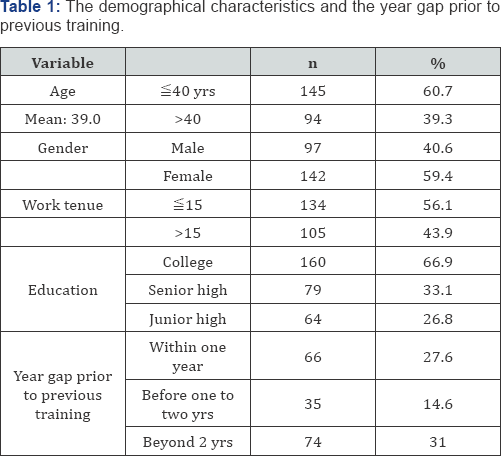
The Highest Willingness to Learn Course of First Aid Rescue
For the four selected items (i.e. A. Hope to receive more courses regarding first aid rescue, B. Which one with most interest, C. The reason for leaning first aid rescue, and D. The barrier to receiving course of first aid rescue), we can see in Table 2 that all distributions in option count are unequally (p<0.05). However, the top priorities for the four selected items are those
a) 80.8% hope to learn first aid rescue techniques,
b) CPR is the top one with the most interest to lean (30.9%),
c) The reason to lean first aid is to rescue family member if necessary (37.5%), and
d) The barrier is the lack of route to learn first aid (28.9%) (Table 2).
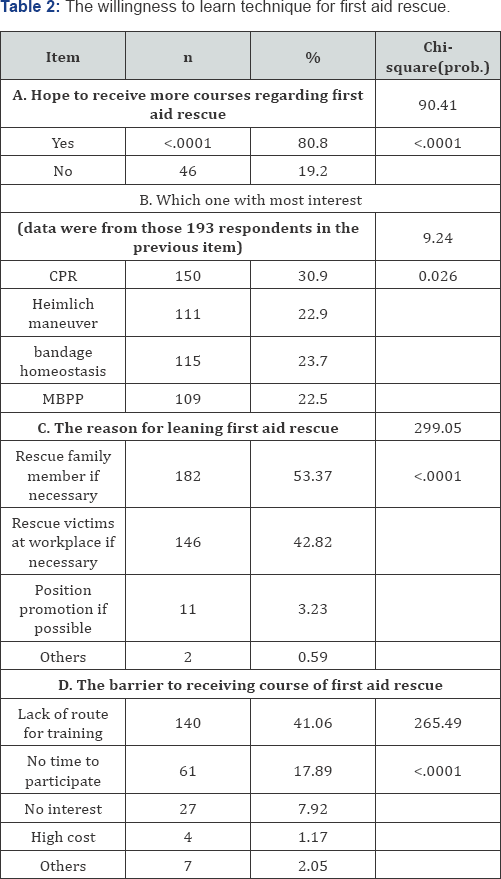
Note: Techniques include cardio-pulmonary Resuscitation (CPR), Heimlich maneuver, bandage hemostasis (BH), and measuring blood, pressure, and pulse (MBPP).
The Willingness Regarding Demographical Characteristics
Chi-square test was performed to investigate the association between willingness and techniques onto demographical characteristics. All of those variables are statistically and significantly associated with each other, see Table 3. The most difficult technique to learn is CPR according to the data from 26.17 in comparison with other counterparts) for gender and those with high willingness (i.e. low proportions (27.05 and the year gap prior to previous training) (Table 3) (Figure 1).
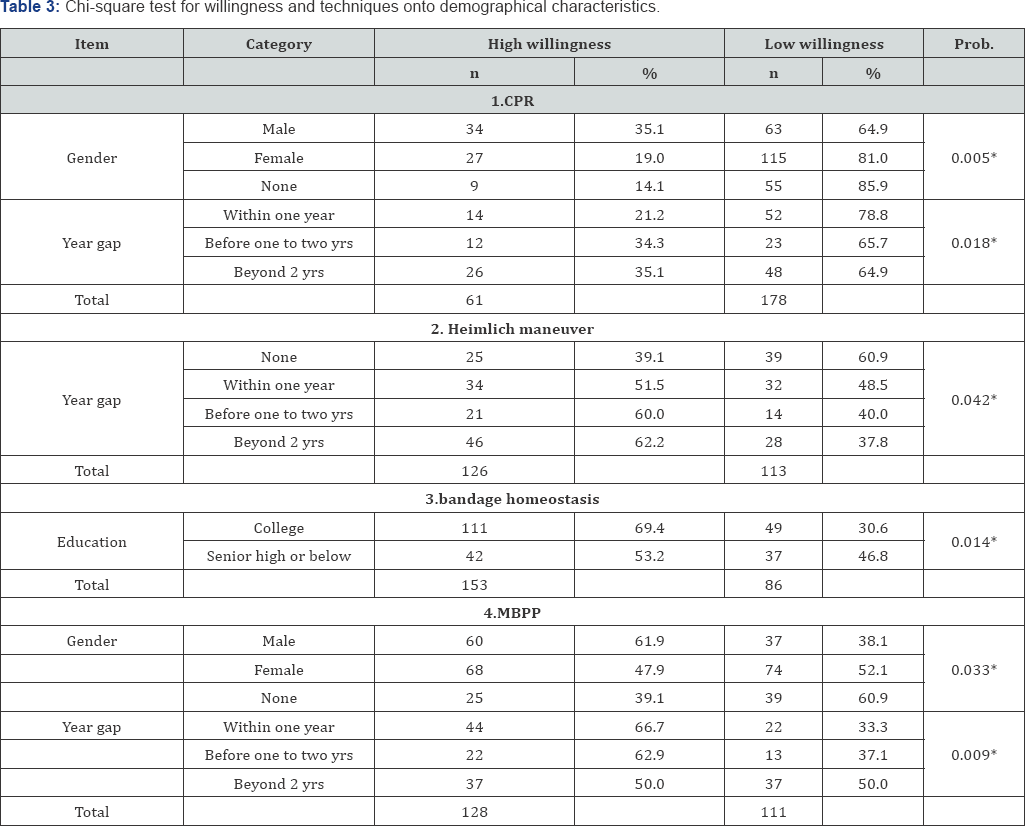
Note: MBPP-measuring blood, pressure, and pulse.
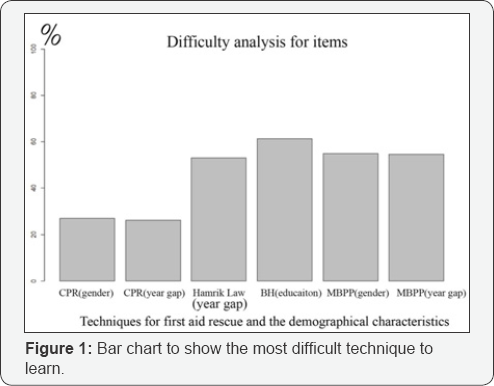
The Barrier Affected the Willingness of Performing the Respective First Aid Rescue
From Table 4, it can be seen that all cross tables are shown significant differences in proportion of count number for each row. The highest proportion across all row is the identical one which is that fears to fail when performing the first aid rescue.
Using SNA to Highlight the Abstract of the Study
The social network can classify three clusters: rescue barrier; rescue willingness; combined analysis of barrier and willingness. We can see (Figure 2) showing that the rescue main barrier is that fear to fail, all of rescue willingness in scenarios is extremely high. The reason for no willingness to perform artificial respiration is afraid of suffering infectious diseases, and for no willingness to perform CPR is that fear to shouldering the law responsibility (Figure 2).
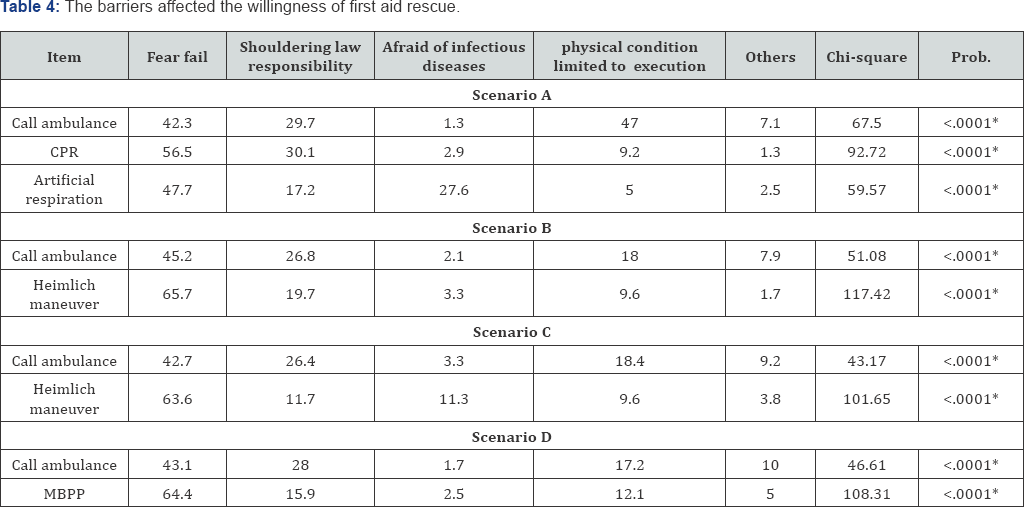
Note: MBPP-measuring blood, pressure, and pulse.
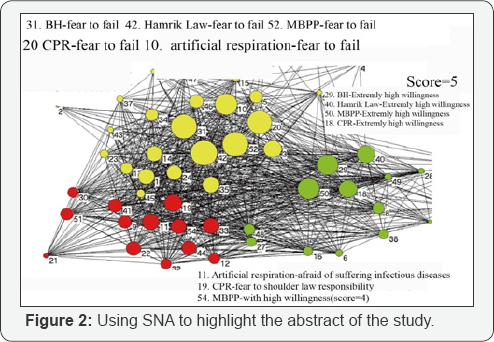
Discussion
We found that in Taiwan hot-spring industry
a) The highest interest to learn technique of first aid rescue is CPR for employees.
b) The main variable affecting the rescue willingness is the year gap prior to the previous training.
c) The main barrier affecting the willingness to rescue is that fear to fail (i.e. insufficient abilities in rescue).
What This Adds to What Was Known
Almost 75% respondents who have received CPR training courses before, which is higher than the study of investigating the willingness and barrier of CPR for nurses in hem dialysis department about 25% receiving CPR training [17]. However, the result is similar to the principle "the motivation from training and the ability from motivation". That is baedon fully implementation of the government regulations of emergency rescue at workplace (i.e. the elementary technician is required to receive 40-hour training course within three years). The year gap prior to the previous training can be shortened and the rescue confidence can be increased. Kuramoto et al. [18] addressed that the ratio of people willing to perform CPR for family member (13%) is near to 2 times to them who are willing to perform CPR for unknown strangers (7%). The result is similar to this study that the ratio is about 1.25 times (53:43 see) (Table 2). According to report regarding hospital cardiac arrest (OHCA) in Taiwan, the 70% of OHCA location is at home, 10% at workplace or other public places. Giving the first aid rescue at right time, many lives can be saved [19].
From the current study, 75% respondents who received CPR training course but 25% have the willingness to rescue victims. In comparison with other Asia countries, Taiwan is similar to Korea and Singapore (about 19~20%) [20,21]. If comparing to other western countries like U.S., Australia and Norway, the ratio of willingness to perform CPR for unknown strangers can reach 50% or above [22-24]. The ratio for willing to rescue with CPR at the hot-spring workplace is required to increase. The finding of association between gender and the year gap prior to the previous training course is similar to the previous study [25]. The male has a higher potential and willingness to perform CPR than the Female, which can be attributed to the requirement of physical power and energy consumption. Relatively, the female has little confidence in performing this first-aid rescue, particularly in CPR.
As for the year gap prior to the previous training course, the less year gap implies the higher willingness to perform first- aid rescue, which phenomenon is related to the confidence and ability in rescue and similar to the result of the previous study [17]. As for the barrier to the willingness, the finding of fearing to fail when performing first-aid rescue is similar to the previous study which investigated on-duty air attendants administering proper emergency procedures in Taiwan [26]. Giving no any training in rescue, no one is willing to or able to perform first aid. Consecutive training is the only way to upgrade the willingness and increase the ability in rescue at workplace.
What It Implies and What Should Be Changed?
When ranking the difficulties of those fundamental rescue techniques, CPR is harder than other else, see Figure 2. We found that the highest interest one to learn is CPR, the most barrier to willingness of rescue is that fears to fail, and the major factor affecting the willingness to rescue is the year gap prior to the previous training course. It is based on fully implementing the government regulations of emergency rescue at workplace (i.e. the elementary technician is required to receive 40 -hour training course within three years). The year gap prior to the previous training can be shortened and the rescue confidence can be increased. We also found that 80.8% respondents are willing to receive more courses related to first aid rescue, the CPR ranks the first place accounting for 30.9%, the motivation to learn CPR is to rescue family member if necessary (37.5%), and the biggest barrier is lacking sufficient the route of training course, see (Table 2). How to integrate social resources and circulate CPR information at workplace is needed to further improve in future.
Strengths of this Study
We applied four scenarios regarding a variety of first aid and their proper occasions to the respondents' willingness and barrier to rescue at the earlier time. The Chi-square test verified that; hot-spring employees who execute CPR with less willingness and low motivation; the biggest barrier to hinder them from performing first aid rescue is lacking a proper learning route (Table 2), and the year gap prior to the previous training course will affect the rescue willingness (Table 3). Furthermore, using R language (see Additional file 1) to draw a bar chart plot and disclose the most difficult rescue technique of CPR (Figure 1). We recommend future researches to apply these types of tables and Figures, especially using the social network analysis (Figure 2), to other fields of occupation workplaces and compare with their similarity and difference. Furthermore, The SLM can be applied to provide us with a framework that we can use it to determine what type of leadership style would be most effective based on our followers' abilities and willingness to perform the desired task such as the first-aid rescue techniques. The basic premise of SLM is that there is no one "best" way to lead a team. In other words, the leadership style we use should be adjusted based on the situation according to the followers’ willingness and abilities. More specifically, it is dependent on the maturity of the specific follower we are trying to influence.
Limitations and Future Study
There are three limitations in the current study. First, the willingness comes from the survey responding data. In real world when the accidence happened, we cannot anticipate the rescue behaviors similar to the level of willingness. Future studies are encouraged to collect data immediately and instantly from respondents in the on-site continuous training course to narrow the gap between intention and behaviors. Another suggests is to adopt the Theory of Planned Behavior, TPB) to make the inference of these relations (i.e. attitude, intention, and behavior) more effective than this study [27,28]. Second, the finding of barrier to willingness to rescue such as that fears to fail cannot generalize the relation to the cause and effect. That is, others such as afraid of shouldering law responsibility fear to suffering infection diseases, and personal physical limitations can be a synergy to construct the barrier to willingness. It is worth studying in the future. Third, due to the research budget limitation, the current study merely collected data from an area of southern Taiwan. Whether any difference will be occurred at other areas or workplaces is needed for further studying.
Conclusion
Our study shows that the willingness for the hot-spring practitioners to perform complete CPR is low. Based on our findings, the major barrier to learn this basic life-saving technique is the lack of suitable learning sources. Recent emergency training course affects the status of rescue. On-site first-aid educations and training systems are required putting more emphases on studies in the future.
References
- Zhang D, Liu X, Liu Y, Sun X, Wang B, et al. (2017) Leisure-time physical activity and incident metabolic syndrome: a systematic review and dose-response meta-analysis of cohort studies. Metabolism 75: 3644.
- Taiwan Government (2017) Statistical data from Taiwan Government Tourism Bureau annual report.
- (2017) Crazy about Hot Springs in Taiwan.
- (2017) Emergency rescue regulation in Taiwan.
- Liu SM (2003) From occupational view to see the education of labor safety and hygiene. Industrial Safety and Hygiene 171: 14-22.
- Hu SC (2001) The evolution of cardiopulmonary resuscitation. TZU CHI Medical Journal 13(3): 143-149.
- Willims D, Shure D (1988) Pulmonary Edema due to Upper Airway Obstruction in Adults. 94(5): 1090-1092.
- Hu SC, Yen DH, Kau WF (2002) Monitoring of Quality Assurance of Emergency Medical Technicians (EMTs) in the Emergency Department. TZU CHI Medical Journal 14(1): 27-33.
- Tien WC (1983) Analysis of pulse rate and blood pressure in highland climbing. Sport academics 5: 35-47.?
- Hersey P, Blanchard KH (1969) Management of Organizational Behavior-Utilizing Human Resources. Prentice Hall, New Jersey, USA, pp. 627.
- Hersey P, Blanchard KH (1969) Life cycle theory of leadership. Training and Development Journal 23 (5): 26-34.
- Hersey P, Blanchard KH (1977) Management of Organizational Behavior 3rd Edition-Utilizing Human Resources. Prentice Hall, New Jersey, USA.
- Liu X, Bollen J, Nelson ML, Van de Sompel H (2005) Co-authorship networks in the digital library research community. Info Process Manag 41(6): 1462-1480.
- Osareh F, Khademi R, Rostami MK, Shirazi MS (2014) Co-authorship Network Structure Analysis of Iranian Researchers’ scientific outputs from 1991 to 2013 based on the Social Science Citation Index (SSCI). Collnet J Scientometr Info Manag 8(2): 263-71.
- Sadoughi F, Valinejadi A, Shirazi MS, Khademi R (2016) Social Network Analysis of Iranian Researchers on Medical Parasitology: A 41 Year Co-Authorship Survey. Iran J Parasitol 11(2): 204 -212.
- Batagelj V, Mrvar A, Pajek (2003) Analysis and Visualization of Large Networks. In Junger M, Mutzel P, (Eds.). Graph Drawing Software, Berlin pp. 77-103.
- Hu KW (2012) Investigating the willingness and barrier of CPR for nurses in hem dialysis department. Master Thesis of Public Health Graduate School in Taiwan National Chen Kung University.
- Kuramoto N, Morimoto T, Kubota Y, Maeda Y, Seki S, et al. (2008) Public perception of and willingness to perform bystander CPR in Japan, Resuscitation 79(3): 475-481.
- MA WM Epidemiological study on emergency medical district in Taipei to those out of hospital cardiac arrest (OHCA). Special project written by Hospital affiliated to National Taiwan University No. Emergency Department of Hospital of Taiwan University: Taipei.
- Cho GC, Sohn YD, Kang KH, Lee WW, Lim KS, et al. (2010) The effect of basic life support education on laypersons’ willingness in performing bystander hands only cardiopulmonary resuscitation, Resuscitation 81(6): 691-694.
- Lateef F, Anantharaman V (2001) Bystander cardiopulmonary resuscitation in pre hospital cardiac arrest patients in Singapore, Pre hospital Emergency Care 5(4): 387-390.
- Coons SJ, Guy MC (2009) Performing bystander CPR for sudden cardiac arrest: Behavioral intentions among the general adult population in Arizona, Resuscitation 80(3): 334-340.
- Jelinek GA, Gennat H, Celenza T, O Brien D , Jacobs I, et al. (2001) Community attitudes towards performing cardiopulmonary resuscitation in Western Australia, Resuscitation 51(3): 239-246.
- Kanstad BK, Nilsen SA, Fredriksen K (2011) CPR knowledge and attitude to performing bystander CPR among secondary school students in Norway, Resuscitation 82(8): 1053-1059.
- Johnston TC, Clark MJ, Dingle GA, Fitz GG (2003) Factors influencing Queenslanders’ willingness to perform bystander cardiopulmonary resuscitation, Resuscitation 56(1): 67-75.
- Lin CR, Tsai J, Hu SC (2000) Analysis of On-Duty Air Attendants Administering Proper Emergency Procedures in Taiwan. Journal of Emergency and Critical Care Medicine 11(2): 59-68.
- Ajzen I (1991) The theory of planned behavior. Organizational Behavior and Human Decision Processes 50(2): 179-211.
- Ajzen I (1985) From intentions to actions: a theory of planned behavior. In J Kuhl and J Beckmann (Eds.) Action control: From cognition to behavior. Berlin: Springer Berlin Heidelberg p. 11-39.






























